
East Prussia was a province of the Kingdom of Prussia from 1773 to 1829 and again from 1878 ; following World War I it formed part of the Weimar Republic's Free State of Prussia, until 1945. Its capital city was Königsberg. East Prussia was the main part of the region of Prussia along the southeastern Baltic Coast.

Bartoszyce is a town on the Łyna River in northern Poland, with 22,597 inhabitants as of December 2021. It is the capital of Bartoszyce County within the Warmian-Masurian Voivodeship.
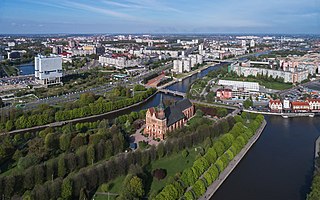
Kneiphof was a quarter of central Königsberg (Kaliningrad). During the Middle Ages it was one of the three towns that composed the city of Königsberg, the others being Altstadt and Löbenicht. The town was located on a 10-hectare (25-acre) island of the same name in the Pregel River and included Königsberg Cathedral and the original campus of the University of Königsberg. Its territory is now part of the Moskovsky District of Kaliningrad, Russia.

Balga was a medieval castle of the Teutonic Knights in Kaliningrad Oblast, Russia. The castle ruins are located on the shore of the Vistula Lagoon, north of Mamonovo in the Pogranichny municipality of Bagrationovsky District, about 30 km (19 mi) southwest of Kaliningrad.

The Königsberg Castle was one of the landmarks of the East Prussian capital Königsberg, Germany.
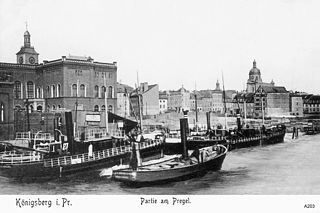
Löbenicht was a quarter of central Königsberg, Germany. During the Middle Ages it was the weakest of the three towns that composed the city of Königsberg, the others being Altstadt and Kneiphof. Its territory is now part of the Leningradsky District of Kaliningrad, Russia.
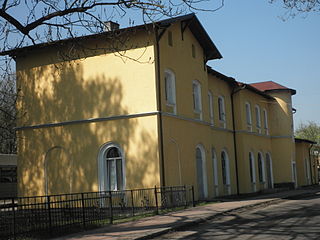
Imeni Alexandra Kosmodemyanskogo is a residential area in Tsentralny Administrative District of the city of Kaliningrad in Kaliningrad Oblast, Russia. It was formerly known by its German language name Metgethen as first a suburb of and then a quarter of Königsberg, located west of the city center.

Altstadt was a quarter of central Königsberg, Prussia. During the Middle Ages it was the most powerful of the three towns that composed the city of Königsberg, the others being Löbenicht and Kneiphof. Its territory is now part of Kaliningrad, Russia.

Königsberg was the historic German and Prussian name of the city that is now Kaliningrad, Russia.

Juditten Church is a Russian Orthodox church in the Mendeleyevo district of Kaliningrad, Russia. originally built as a Roman Catholic church, it later become a Prussian Union (Protestant) church. Juditten was the name of the Mendeleyevo district when it was a quarter of Königsberg, East Prussia, Germany. It is the oldest building of Kaliningrad.
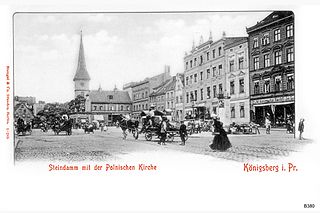
Steindamm was the oldest quarter of Königsberg, Germany. Its territory is now part of Kaliningrad, Russia.

Steindamm Church, St Nicholas' Church, or Polish Church, Old Lithuanian Church was the oldest church in the city formerly known as Königsberg, and today known as Kaliningrad, Russia.
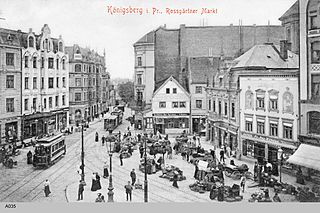
Rossgarten was a quarter of northeastern Königsberg, Germany. It was also occasionally known as Altrossgarten (Altroßgarten) to differentiate it from Neurossgarten in northwestern Königsberg. Its territory is now part of the Leningradsky District of Kaliningrad, Russia.

Burgfreiheit or Schlossfreiheit was a quarter of Königsberg, Germany. Its territory is now part of Kaliningrad, Russia.

Dimitrovo is part of the Moskovsky District of Kaliningrad, Russia. Until 1947, it was known by its German language name Ponarth as first a suburb of and then a quarter of Königsberg, Germany, located southwest of the city center.

Severnaya Gora is part of the Leningradsky District in northern Kaliningrad, Russia. It was formerly known by its German language name Quednau as first a suburb of and then a quarter of Königsberg, Germany.

Quednau Church was a Protestant church in northern Königsberg, Germany.
Mendeleyevo is a rural locality in the Guryevsky District, Kaliningrad Oblast, Russia.

Mendeleyevo is part of the Tsentralny District in Kaliningrad, Russia. Until 1947, it was known by its German name Juditten as first a suburb of and then a quarter of Königsberg, Germany. Juditten Church was a site of pilgrimage since the Middle Ages. The philosopher Johann Christoph Gottsched was born in Juditten in 1700.
Neuendorf Church was a Protestant church in the Adlig Neuendorf quarter of Königsberg, Germany.

















